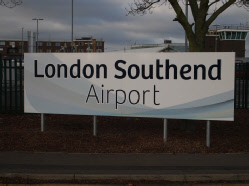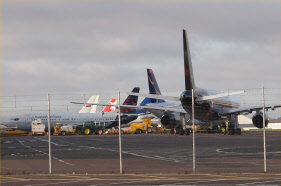

Make a point of visiting us weekly! Tell a friend about us.
London Southend Airport
6. A Question of Noise
6. A Question of Noise

Talking with David Lister, Operations Director of London Southend Airport
(November 2013)
(November 2013)
A little while ago we received a flyer from the SAEN campaign on which there was an e-
Rochford Life: David how long have you been in this role?
David: I’ve been here since January 2013. Alistair moved on in July. He was the managing director and I’m, in essence, the lead director here at the airport, but I am not the Managing Director as such; they haven’t replaced Alistair but I am doing a large part of what his role entailed. My role is running the airport, effectively, all of the aspects associated with that.
RL: When I spoke to Alistair I am sure he once said, we’re not allowed night flights after a certain time. Does that still apply?
David: Basically, as part of our planning permissions and agreements with the Local Council we agree to restrict night flights and so between the hours of 23.30 and 06.30 we have a cap on the number of flights that exist and between the hours of 23.00 and 23.30 we also control the number of flights. I think it is an average of about four per night.
RL: I presume that gets heavier in the summer and lighter in the winter, does it?
David: No, we have one scheduled passenger movement between 23.00 and 06.30 every day and that doesn’t change summer to winter and the rest is just ad hoc flights, we don’t schedule any movements, so it’s not a major part of our business.
RL: So that would include planes that come here for repair and maintenance, I assume?
David: That would be included in that, yes. The only exceptions are if a flight is scheduled to come in at 23.00 say and it was late, then that is not counted as part of that quota. There is in fact a very significant reduction in night flights, because there was no restriction previously, before the airport expanded and today.
RL: Is it easy to get information about the airport?
David: It depends on what information you want. For instance we published an annual report that has a large amount of information about the airport, and we also respond to requests for information etc. where reasonable. We won’t respond in volume where it would be necessary for me to employ someone full time just to deal with information but for reasonable requests for information we provide the information. Our web-
RL: Is the new terminal development running a bit late at the moment?
David: No, we started phase 2 of the terminal back in January and we occupied the first section of that back in June and this month we are opening the new security area, next month will be expanding the check-
RL: There has been talk about increased employment. Is that to do with the airport or with the industrial estate?
David: It’s both but the airport is a very big driver of it. If you go back to 2012 the airport handled 42,000 passengers, last year 700,000, and this year it will be over a million, and that requires additional people employed to enable us to do it and if you look at our annual report we’ve met the employment commitments we made. As passenger number increase so are likely employment figures.
RL: When you reach your two million target, do you think you’ll be able to maintain the incredibly high standard and speed of passenger delivery that you have at the moment?
David: We were obviously very pleased to be able to win the Which award where we were voted the best in the country, and that voting took place during the current construction phase. The whole reason we’re building the extension to the terminal is in order that we have the space to continue to provide the same high level of service as we grow the number of passengers, that is absolutely what our intention is.
RL: How about the ongoing problem of noise from the airport?
David: We are aware of course that we have a local community near by and that there is noise that is clearly associated with the airport and we have a number of controls in place in order to minimise the impact, but with an airport unfortunately there is always going to be a certain level of noise. At least there are controls now, because prior to the controls it was unlimited, and the runway extension allowed us to use more fuel-
RL: On the subject of noise, I believe you are about to use a new plane?
David: easyjet are launching a new route to Tenerife using an A320 rather than the existing fleet of A319’s. It’s all part of the A320 series so Airbus have a series called the A320 which includes the A319, the A320 and the A321 and it’s the same design, the same wingspan, the same engines but it’s just a few metres longer in order to accommodate a few more seats so you and I would be very unlikely to be able to tell the difference.
RL: Does it make slightly more noise?
David: Well it is the same engines on the aircraft so the noise pattern is very similar.
RL: I would have thought that planes taking off with a full payload have to make just that much more effort and are therefore noisier.
David: I’m not an expert at aircraft performance so I can’t really comment on that but the way that the noise is evaluated does look at aircraft performance and we do produce noise contours on a regular basis for the overall impact of the airport. But, as I say, the aircraft is of the same family but will carry slightly more passengers than the existing aircraft. In fact they are not intending to fill this particular aircraft to ensure the range they want for it – to get to Tenerife.
RL: With a goal of two million passengers, I assume there has to be constant expansion of routes?
David: Yes, we’re always talking to easyjet about new routes and they will evaluate their existing route network and determine whether everything is working as well for them as it can do and look at potential new routes and over the coming years we want to continue to grow the destinations available from the airport.
RL: David, thank you very much for sharing; we appreciate your time.
General Comment:
- The first three points made by SAEN on their flyer were criticisms of the two Councils involved. From the interviews we have conducted with elected members of Rochford District Council the clear impression conveyed is that the Council have arrived at their conclusions a) after public consultation which was not entirely against the airport and b) sought to provide amenity and employment for the local district while nevertheless maintaining a number of curbs on the running of the airport.
- Throughout its existence, Rochford Life has sought to inform its readers as to the workings of the Council and encouraged people to take an interest and even make their voice heard. Council members are always available to talk. The impression that we are left with is that members of the objectors did little to lobby local councillors beforehand. We are of course open to hear that it was to the contrary but while our attempts to make contact are ignored, we are unable to comment further.
- which we would have thought objectors would have been glad about! For a full understanding of the number of permitted flights, readers should go to the Operational Controls Summary Table on the airport’s web-site. SAEN speaks of fighting 5 million passenger growth but as we have been told the target figure for 2020 is 2 million this appears a little like scare mongering.
-
-
